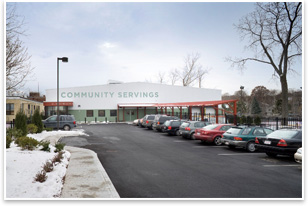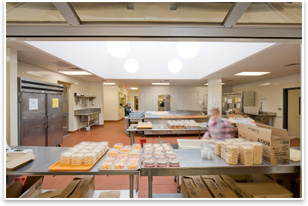Serving Up a New Kitchen Facility for a Meal Delivery Service
Boston meal delivery organization expands by moving into reused warehouse space
by Russell Boniface
Associate Editor
 How do you . . . design a large, contemporary kitchen and storage space for a community organization on a limited budget? How do you . . . design a large, contemporary kitchen and storage space for a community organization on a limited budget?
Summary: Boston-based Community Servings, a nonprofit meal delivery organization, recently completed its new 13,500-square-foot restaurant-style kitchen facility. Community Servings’ staff and volunteers deliver free meals to ill, homebound persons, domestic-violence shelters, assisted-living complexes, and nursing homes. KlingStubbins, based in Cambridge, Mass., adapted a Boston warehouse for the new $7 million kitchen facility, which allows Community Servings to double its daily home-delivered meals from 1,300 to 2,600 throughout greater Boston.
 The new Community Servings kitchen in Boston’s Jamaica Plain adapts a one-time warehouse, expands on the previous 5,700-square-foot space situated along Boston’s subway system. The building includes a production kitchen, storage facilities, and office space. Chris Leary, AIA, principal and project director at KlingStubbins, says the Community Servings kitchen project, which the firm took on for a reduced fee, was small in terms of scale but significant in importance. “Community Servings is a terrific organization that serves and looks out for people. They have a great base of donors and supporters, and they funnel money back to their clients,” he says. “As a commercial firm, it’s a challenge to do a project that you’re not doing as a for-profit or a break-even proposition, but it was money we planned to donate, which at the end of the day the firm feels good about, and our staff found it rewarding. The project gave back beyond conventional profit expectations.” The new Community Servings kitchen in Boston’s Jamaica Plain adapts a one-time warehouse, expands on the previous 5,700-square-foot space situated along Boston’s subway system. The building includes a production kitchen, storage facilities, and office space. Chris Leary, AIA, principal and project director at KlingStubbins, says the Community Servings kitchen project, which the firm took on for a reduced fee, was small in terms of scale but significant in importance. “Community Servings is a terrific organization that serves and looks out for people. They have a great base of donors and supporters, and they funnel money back to their clients,” he says. “As a commercial firm, it’s a challenge to do a project that you’re not doing as a for-profit or a break-even proposition, but it was money we planned to donate, which at the end of the day the firm feels good about, and our staff found it rewarding. The project gave back beyond conventional profit expectations.”
 Large space provides efficient flow for work and material Large space provides efficient flow for work and material
Leary says Community Servings needed a larger kitchen space as its services grew. “They found an affordable warehouse in industrial Jamaica Plain with subway accessibility. Usually, affordable, accessible, and industrial do not go together.”
The building was re-skinned, and most structural elements were retained. An assembly-line kitchen was installed to allow for a safe, efficient flow of material. “The heart of the building is the kitchen,” explains Leary. “Raw materials and packaged goods come off a truck and are brought into refrigerators, freezers, and dry-good storage. Materials flow into a preparation area at the front where, for example, vegetables are chopped and items are unpackaged by volunteers. The product then flows into the kitchen at the back, where the professional chefs work. Because that environment is professional, it’s a bit more dangerous, so there’s separation between where the professionals work and where the volunteers work. The preparation space, once cleaned, turns around to double as the packaging area as the meals come back out.”
 The size and flow of the facility allow Community Services to double the people and geography it serves. The staff’s “pulse” factored into the design, Leary notes. “It’s a two-shift volunteer operation. Every day at 11 o’clock, a half-dozen vans load up meals, which then leave to deliver them. Volunteers clean the facility, and then an afternoon/evening volunteer crew starts the preparation work for the next day’s meals. The professional kitchen staff gets there early the next morning and prepares the meals, the meals are packaged, and the trucks are loaded to begin the cycle again.” The size and flow of the facility allow Community Services to double the people and geography it serves. The staff’s “pulse” factored into the design, Leary notes. “It’s a two-shift volunteer operation. Every day at 11 o’clock, a half-dozen vans load up meals, which then leave to deliver them. Volunteers clean the facility, and then an afternoon/evening volunteer crew starts the preparation work for the next day’s meals. The professional kitchen staff gets there early the next morning and prepares the meals, the meals are packaged, and the trucks are loaded to begin the cycle again.”
Leary commends Community Services for its professionalism. ”We were trying to squeeze every bit of efficiency out of this building, and they understood how the material would flow, how the pathways would line up, and how the planning would work. They are very organized and fiscally responsible.”
 Making decisions on a nonprofit project Making decisions on a nonprofit project
“One challenge of the project was knowing that the client is feeding people for five dollars each per day, so you feel compelled to save every penny,” Leary states. “But it’s also an investment. Some features of the project you could argue weren’t necessary, such as a skylight and graphics on the outside. But you have to realize a bigger picture—the quality of the environment is why volunteers come back. Plus, the image of the building—they are very proud of who they are. It also had to be solid and functional. We had a situation to do a cheaper floor, but there was a concern it wouldn’t be as cleanable and durable, and they can’t afford to miss a day of cooking. So you have to be careful on how you make judgments on what’s appropriate. On the one hand, you’re squeezing every penny, and on the other hand you’re investing in helping them do more.”
Leary feels the appreciation he and KlingStubbins received in return was immeasurable. “Community Services makes you feel like you’re part of the family. They bring the folks they help back into the organization, and when we go down and volunteer we see the people we’re helping. We feel great about participating in the project.”
|






